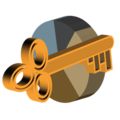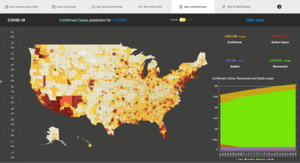PolyAnalyst
 | |
| Developer(s) | Megaputer Intelligence |
|---|---|
| Initial release | 1994[1] |
| Stable release | 6.5
|
| Type | Data science, artificial intelligence, text mining, predictive analytics |
| Website | www |
PolyAnalyst is a data science software platform developed by Megaputer Intelligence that provides an environment for text mining, data mining, machine learning, and predictive analytics. It is used by Megaputer to build tools with applications to health care, business management, insurance, and other industries. PolyAnalyst has also been used for COVID-19 forecasting and scientific research.
Overview[edit]

PolyAnalyst's graphical user interface contains nodes that can be linked into a flowchart to perform an analysis. The software provides nodes for data import, data preparation, data visualization, data analysis, and data export.[2][3] PolyAnalyst includes features for text clustering, sentiment analysis, extraction of facts, keywords, and entities, and the creation of taxonomies and ontologies. Polyanalyst supports a variety of machine learning algorithms, as well as nodes for the analysis of structured data and the ability to execute code in Python and R.[4][5] PolyAnalyst also acts as a report generator, which allows the result of an analysis to be made viewable by non-analysts.[6] It uses a client–server model and is licensed under a software as a service model.[6]
Business Applications[edit]
Insurance[edit]
PolyAnalyst was used to build a subrogation prediction tool which determines the likelihood that a claim is subrogatable, and if so, the amount that is expected to be recovered.[citation needed] The tool works by categorizing insurance claims based on whether or not they meet the criteria that are needed for successful subrogation.[citation needed] PolyAnalyst is also used to detect insurance fraud.[7]
Health care[edit]

PolyAnalyst is used by pharmaceutical companies to assist in pharmacovigilance. The software was used to design a tool that matches descriptions of adverse events to their proper MedDRA codes, determines if side effects are serious or non-serious, and to set up cases for ongoing monitoring if needed.[8] PolyAnalyst has also been applied to discover new uses for existing drugs by text mining ClinicalTrials.gov,[9] and to forecast the spread of the COVID-19 virus in the United States and Russia.[10][11]
Business management[edit]
PolyAnalyst is used in business management to analyze written customer feedback including product review data, warranty claims, and customer comments.[12] In one case, PolyAnalyst was used to build a tool which helped a company monitor its employees' conversations with customers by rating their messages for factors such as professionalism, empathy, and correctness of response. The company reported to Forrester Research that this tool had saved them $11.8 million annually.[13]
SKIF Cyberia Supercomputer[edit]
PolyAnalyst is run on the SKIF Cyberia Supercomputer at Tomsk State University, where it is made available to Russian researchers through the Center for Collective Use (CCU). Researchers at the center use PolyAnalyst to perform scientific research and to management the operations of their universities.[14] In 2020, researchers at Vyatka State University (in collaboration with the CCU) performed a study in which PolyAnalyst was used to identify and reach out to victims of domestic violence through social media analysis. The researchers scraped the web for messages containing descriptions of abuse, and then classified the type of abuse as physical, psychological, economic, or sexual. They also constructed a chatbot to contact the identified victims of abuse and to refer them to specialists based on the type of abuse described in their messages. The data collected in this study was used to create the first ever Russian-language corpus on domestic violence.[15][16]
References[edit]
- ^ Kiselev, Mikhail V. (1994). "PolyAnalyst - A Machine Dis covery System Inferring Functional Programs" (PDF). AAAI Technical Report. AAAI-94 Workshop on Knowledge Discovery in Databases (WS-94-03). AAAI: 237-249. Retrieved 15 March 2021.
- ^ Apicella, Mario (3 July 2000). "PolyAnalyst 4.1 digs through data for gold". Info World.
- ^ Zhang, Qingyu; Segall, Richard S. (1 December 2008). "Web mining: a survey of current research, techniques, and software". International Journal of Information Technology & Decision Making. 7 (4): 683–720. doi:10.1142/S0219622008003150. ISSN 0219-6220.
- ^ Zhang, Qingyu; Segall, Richard S. (1 January 2010). "Review of data, text and web mining software". Kybernetes. 39 (4): 625–655. doi:10.1108/03684921011036835. ISSN 0368-492X.
- ^ Zhang, Qingyu; Segall, Richard S. (2009), Maimon, Oded; Rokach, Lior (eds.), "Commercial Data Mining Software", Data Mining and Knowledge Discovery Handbook, Boston, MA: Springer US, pp. 1245–1268, Bibcode:2010dmak.book.1245Z, doi:10.1007/978-0-387-09823-4_65, ISBN 978-0-387-09823-4, retrieved 3 October 2020
- ^ a b Halper, Fern (2011). "Predictive Analytics: The Hurwitz Victory Index Report" (PDF). Hurwitz & Associates. Retrieved 28 September 2020.
- ^ Wang, John; Yang, James G.S. (2009). "Data mining techniques for auditing attest function and fraud detection" (PDF). Journal of Forensic & Investigative Accounting. 1 (1): 1–24.
- ^ "Life sciences: Increasing speed-to-insight in pharma". kmworld.com. Retrieved 22 September 2020.
- ^ Su, Eric Wen; Sanger, Todd M. (23 March 2017). "Systematic drug repositioning through mining adverse event data in ClinicalTrials.gov". PeerJ. 5: e3154. doi:10.7717/peerj.3154. ISSN 2167-8359. PMC 5366063. PMID 28348935.
- ^ "COVID-19: Megaputer provides interactive geo-map to forecast peak of active cases in U.S." thegeospatial. 29 April 2020. Retrieved 30 September 2020.
- ^ "В России представили модели пика заболеваемости COVID-19 в регионах". РБК (in Russian). 17 May 2020. Retrieved 24 September 2020.
- ^ Richard S. Segall; Qingyu Zhang. "Web Mining of Hotel Customer Survey Data". Systemics, Cybernetics and Informatics. 6 (6): 23–29. CiteSeerX 10.1.1.455.7659.
- ^ Evelson, Boris (10 November 2015). "Vendor Landscape: Big Data Text Analytics". Forrester.
- ^ редакция, Любимая. "В ТГУ открылся Центр коллективного пользования платформой для аналитики big data". Томский Обзор (in Russian). Retrieved 26 February 2021.
- ^ "Ученые ВятГУ совместно с компанией Мегапьютер Интеллидженс разработали чат-бот для помощи жертвам супружеского насилия - Официальный сайт ВятГУ". vyatsu.ru. Retrieved 26 February 2021.
- ^ "Суперкомпьютер помогает находить в интернете жертв домашнего насилия | iot.ru Новости Интернета вещей". iot.ru. Retrieved 26 February 2021.
External links[edit]
- Text mining
- Data mining and machine learning software
- Reporting software
- Software associated with the COVID-19 pandemic
- Business software
- Software frameworks
- Text analysis
- Proprietary software
- Natural language processing software
- Data analysis software
- Data visualization software
- Computing platforms
- Data management software
- Knowledge management
- 1994 software
- Ontology editors
- Windows software
